6.1. Files, images and video¶
These artefacts are internal Mahara ones to display:
- links to files that you have uploaded
- folders that contain files
- show images
- embed audio and video files
6.1.1. File(s) to download¶

Select files that viewers of your portfolio can download.
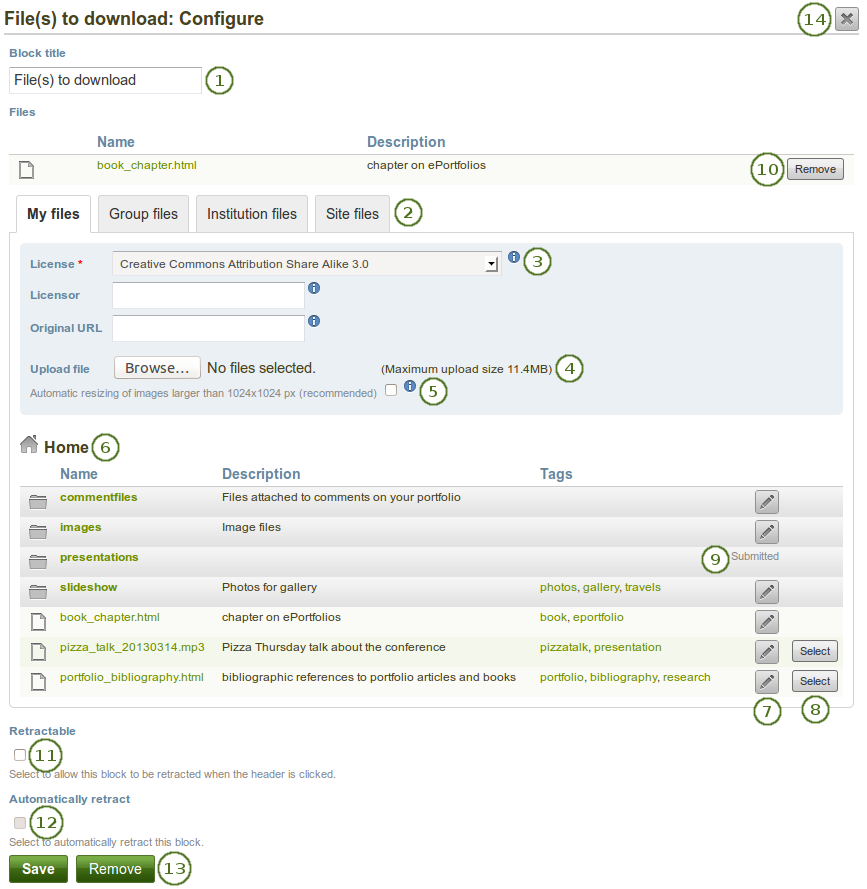
Configure the File(s) to download block
Block title: Choose a title for your files block.
Files area: Choose from which files area you would like to select a file:
- My files: You see all the folders and files that you have created.
- Group files: You see all the folders and files that you are allowed to publish.
- Institution files: If you are an institution administrator, you will see institution folders and files.
- Site files: If you are a site administrator, you will see all site folders and files. Otherwise, you can only see the ones that are in the folder public in the Site files.
License information: You see these fields if the site administrator turned on license metadata. Additionally, if you are in an institution, your institution administrator may require you to provide a license.
- License: Your default license is displayed. You can set your default license in your account settings. You may choose a different license for each individual artefact.
- Licensor: If you are uploading a file that somebody else created, you can attribute the work to them here and provide their name for example.
- Original URL: If you are uploading somebody else’s file, provide a link to the original Internet address so that others can go there and view the original file.
Upload file: You do not have to go back to your Files area in Content in order to upload a file. You can do so directly from this screen.
If the site administrator turned on the image resizing option, you can decide whether you want to have your images resized if they are larger than the specified dimensions. This option is recommended to save space in your portfolio.
Folder path: The breadcrumbs show in which folder you are currently.
You can still edit any component of the file, i.e. its file name, description and tags by clicking the Edit button.
Choose the file or files you wish to display by clicking the Select button.
Warning
When you place group, institution or site files into a page, beware that these files may not be available at some point anymore when the person in charge deletes them.
You can also still select files (within folders) that have been submitted in another portfolio page.
Click the Remove button to not display a specific file in this block anymore.
Retractable: Tick this checkbox if you want to allow users to reduce the block to its heading on a page. The user can click the Retractable icon
 to just show the heading.
to just show the heading.Automatically retract: Tick this checkbox if you want to show only the block’s heading when a user views the page. The user can click the Retracted icon
 to view the entire block.
to view the entire block.Click the Save button to accept your changes, or click the Cancel button to leave the block’s content as it is. The Remove button is shown only when you place the block into the page for the first time.
You can also click the Close button
 in the top right-hand corner to either remove a newly created block before it is being saved or to cancel any changes and leave the block’s content as it is.
in the top right-hand corner to either remove a newly created block before it is being saved or to cancel any changes and leave the block’s content as it is.
Note
You cannot re-order files once you have selected them. You would need to remove them and select them again in the correct order.
When the block is placed on the portfolio page, the following information is displayed:
- file name
- file description
- size
- upload date
- a link to more details
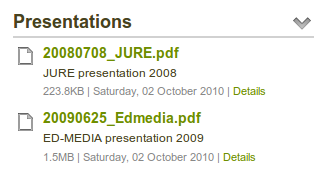
Details about files that can be downloaded.
If you choose to retract your block, you only see the block’s heading and the Retracted icon  . When you click on it, you can see the block’s content.
. When you click on it, you can see the block’s content.

Block when it is retracted
When users click on the Details link, they are taken to the details page for that particular file and see some more metadata.
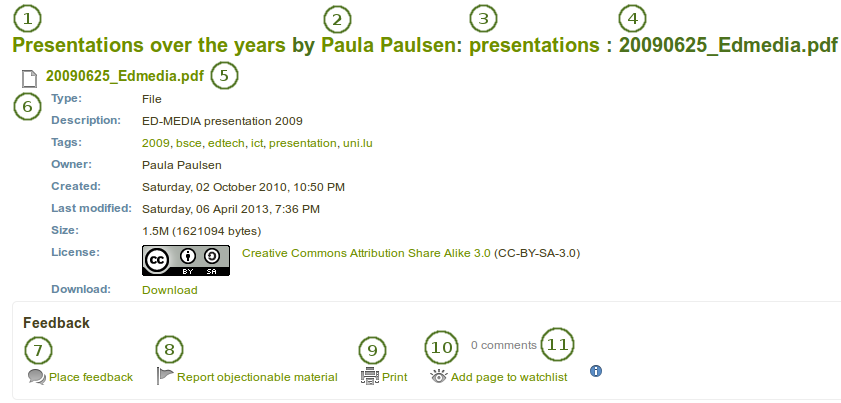
More details about a file that can be downloaded.
- The title of the page in which the artefact appears is linked.
- The author of the page is displayed and a link to the profile page provided.
- If the file has been made available within the Folder blocktype, the folder is linked so you can view the other files as well.
- The name of the file is displayed.
- The name of the file is displayed again but with a link and a file icon.
- Additional metadata is displayed for the file:
- file type
- description
- tags
- owner
- creation date
- last modified date
- size
- license (if license information is turned on by the site administrator)
- download link
- If the owner of the file allowed comments, you can place feedback directly on the file.
- You can also report this file if it contains objectionable content by clicking on the Report objectionable material link.
- You can print the metadata page via the Print link.
- You can add the page in which the artefact appears to your watchlist by clicking on the Add page to watchlist link.
- View the number of comments left on this artefact.
6.1.2. Folder¶

Select a folder to display all files within it as links on your page.
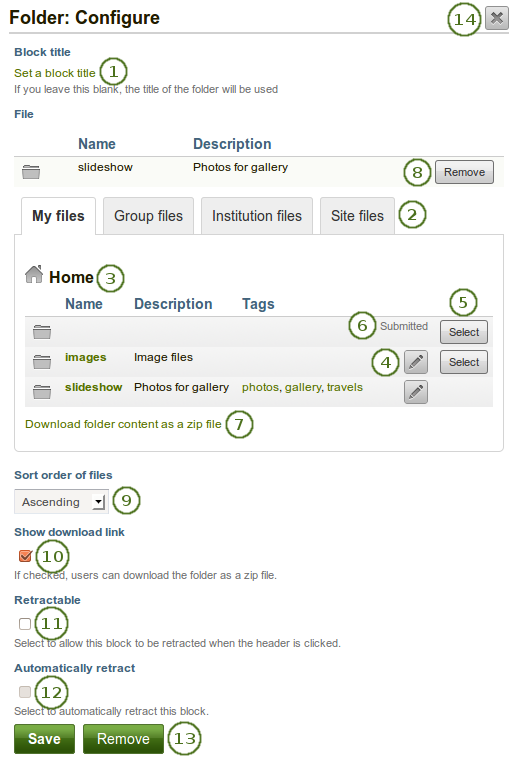
Configure the Folder block
Block title: If you do not set a title, the name of the folder that you choose to display will be used.
Files area: Choose from which files area you would like to select a folder:
- My files: You see all the folders and files that you have created.
- Group files: You see all the folders and files that you are allowed to publish.
- Institution files: If you are an institution administrator, you will see institution folders and files.
- Site files: If you are a site administrator, you will see all site folders and files. Otherwise, you can only see the ones that are in the folder public in the Site files.
Folder path: The breadcrumbs show in which folder you are currently.
You can edit any component of the folder, i.e. its name, description and tags by clicking on the Edit button.
Choose the folder you wish to display by clicking on the Select button.
You can also still select folders that have been submitted in another portfolio page.
 Click the Download folder content as zip file link in order to get a zip file which contains all files and folders of the current folder.
Click the Download folder content as zip file link in order to get a zip file which contains all files and folders of the current folder.See also
Site administrators decide in the Artefact type: File settings for how long the zip file is kept on the server.
Click the Remove button if you wish to revert your choice.
 Sort order of files: Decide on the sort order of files in the block when they are displayed on the page. You can choose between:
Sort order of files: Decide on the sort order of files in the block when they are displayed on the page. You can choose between:- Ascending
- Descending
See also
Site administrators decide on the default sort order of content within folder in the Blocktype: File / folder settings.
 Show download link: Tick the download link checkbox if you wish to allow the viewers of your page to download the folder contents as zip file.
Show download link: Tick the download link checkbox if you wish to allow the viewers of your page to download the folder contents as zip file.See also
Site administrators decide in the Blocktype: File / folder settings whether users are allowed to display the download link or not.
Retractable: Tick this checkbox if you want to allow users to reduce the block to its heading on a page. The user can click the Retractable icon
 to just show the heading.
to just show the heading.Automatically retract: Tick this checkbox if you want to show only the block’s heading when a user views the page. The user can click the Retracted icon
 to view the entire block.
to view the entire block.Click the Save button to accept your changes, or click the Cancel button to leave the block’s content as it is. The Remove button is shown only when you place the block into the page for the first time.
You can also click the Close button
 in the top right-hand corner to either remove a newly created block before it is being saved or to cancel any changes and leave the block’s content as it is.
in the top right-hand corner to either remove a newly created block before it is being saved or to cancel any changes and leave the block’s content as it is.
Warning
When you place a folder with group, institution or site files into a page, beware that these files may not be available at some point anymore when the person in charge deletes them.
6.1.3. Image gallery¶

Select a folder with images or individual images to show in a gallery or embed an external image gallery.
6.1.3.1. Image gallery with uploaded images¶
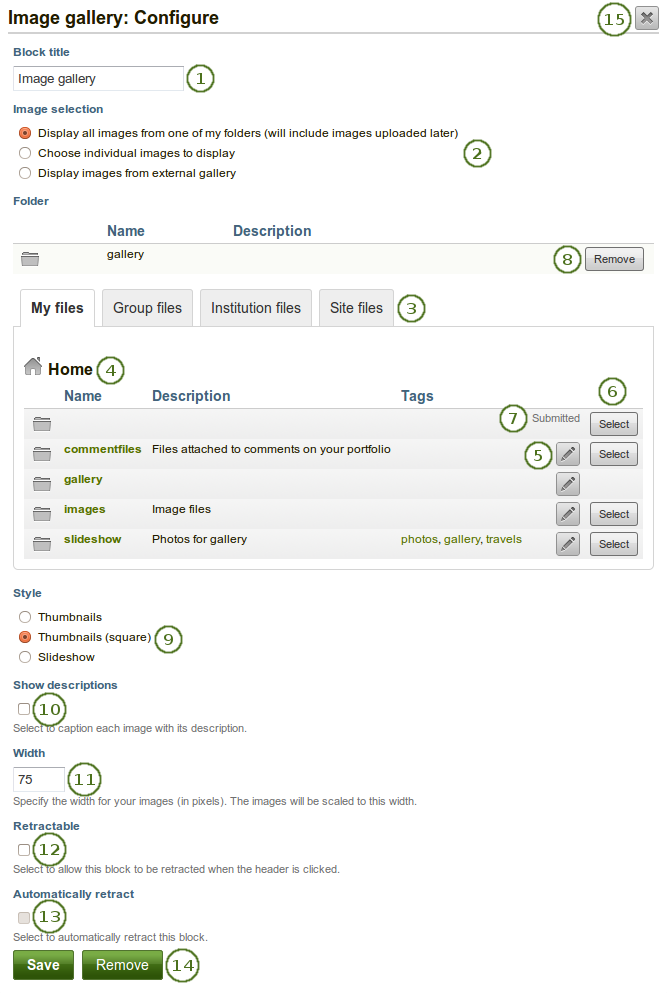
Configure the Image gallery block with internal images
Block title: Choose a title for your image gallery block.
Image selection: You can choose to display all images from a specific folder or you can select the images individually.
Files area: Choose from which files area you would like to select an image:
- My files: You see all the folders and files that you have created.
- Group files: You see all the folders and files that you are allowed to publish.
- Institution files: If you are an institution administrator, you will see institution folders and files.
- Site files: If you are a site administrator, you will see all site folders and files. Otherwise, you can only see the ones that are in the folder public in the Site files.
Folder path: The breadcrumbs show in which folder you are currently.
Click the Edit button to change any component of the folder, i.e. its name, description and tags. If you have a folder or file included in a page that you submitted for feedback, you will not be able to edit the file.
Click the Select button to choose the folder or file you wish to display in your image gallery.
Note
If you selected to display an entire folder in your image gallery, new images that you upload to that folder are added to your gallery automatically.
You can also still select folders or files that have been submitted in another portfolio page.
Click the Remove button if you want to revert your selection.
Style: Decide to show all selected images as thumbnails or as slideshow where you only see one image at a time. If you select the option “Thumbnails (square)”, all your images will be displayed in the same size as thumbnails.
Note
If you select to display your images in a slideshow, you can navigate all images with the help of the icons Next
 and Previous
and Previous  .
.  Use the icons First
Use the icons First  and Last
and Last  to start or end your slideshow.
to start or end your slideshow. Show descriptions: Select this checkbox if you want to display the image descriptions in the gallery.
Show descriptions: Select this checkbox if you want to display the image descriptions in the gallery.Width: Specify the width (in pixels) for your images. The images are scaled to this width.
Retractable: Tick this checkbox if you want to allow users to reduce the block to its heading on a page. The user can click the Retractable icon
 to just show the heading.
to just show the heading.Automatically retract: Tick this checkbox if you want to show only the block’s heading when a user views the page. The user can click the Retracted icon
 to view the entire block.
to view the entire block.Click the Save button to accept your changes, or click the Cancel button to leave the block’s content as it is. The Remove button is shown only when you place the block into the page for the first time.
You can also click the Close button
 in the top right-hand corner to either remove a newly created block before it is being saved or to cancel any changes and leave the block’s content as it is.
in the top right-hand corner to either remove a newly created block before it is being saved or to cancel any changes and leave the block’s content as it is.
Warning
When you place group, institution or site files into a page, beware that these files may not be available at some point anymore when the person in charge deletes them.
6.1.3.2. Image gallery from external images¶
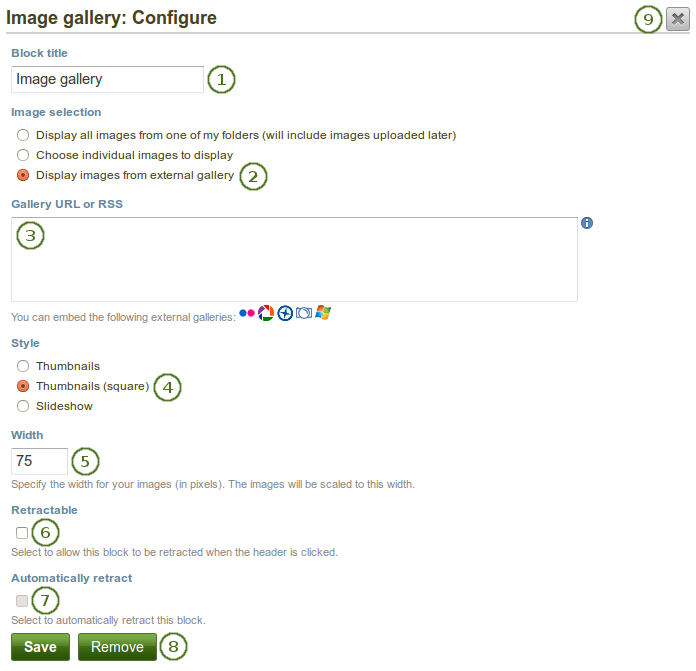
Configure the Image gallery block with external images
Block title: Choose a title for your image gallery block.
Image selection: Select the option “Display images from external gallery”.
Gallery URL or RSS: Copy the link to the external gallery and past it into the text box. You can embed the following external galleries:
- Flickr, e.g. http://www.flickr.com/photos/12345678@N01/sets/98765432123456789/
- Panoramio, e.g. http://www.panoramio.com/user/123456
- Photobucket, e.g. http://s1234.photobucket.com/albums/ee123/username/ or http://s1234.photobucket.com/albums/ee123/username/AlbumName/
- Picasa, e.g. http://picasaweb.google.com/user.name/AlbumName#
- Windows Live Photo Gallery, e.g. http://cid-123456ab7890cd12.photos.live.com/self.aspx/AlbumName/photo.jpg
Note
- To use Flickr, the site administrator has to provide a valid API key.
- To use Photobucket, the site administrator has to provide a valid API key and a secret API key.
- For Windows Live Photo Gallery to work properly, the link to one of the photos inside the album must be copied and pasted into the text box in order to show the entire album.
Style: Decide to show all selected images as thumbnails or as slideshow where you only see one image at a time. If you select the option “Thumbnails (square)”, all your images will be displayed in the same size as thumbnails.
Width: Specify the width (in pixels) for your images. The images are scaled to this width.
Retractable: Tick this checkbox if you want to allow users to reduce the block to its heading on a page. The user can click the Retractable icon
 to just show the heading.
to just show the heading.Automatically retract: Tick this checkbox if you want to show only the block’s heading when a user views the page. The user can click the Retracted icon
 to view the entire block.
to view the entire block.Click the Save button to accept your changes, or click the Cancel button to leave the block’s content as it is. The Remove button is shown only when you place the block into the page for the first time.
You can also click the Close button
 in the top right-hand corner to either remove a newly created block before it is being saved or to cancel any changes and leave the block’s content as it is.
in the top right-hand corner to either remove a newly created block before it is being saved or to cancel any changes and leave the block’s content as it is.
6.1.4. Some HTML¶

Display the content of an HTML file in a page.
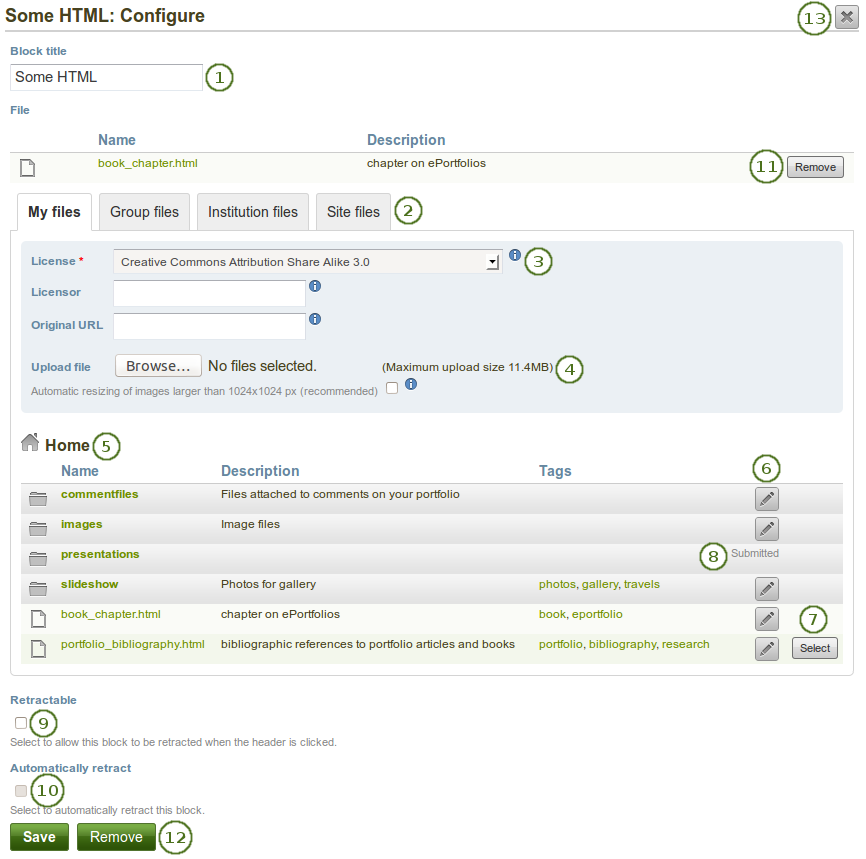
Configure the HTML block
Block title: Choose a title for your block.
Files area: Choose from which files area you would like to select an HTML file:
- My files: You see all the folders and files that you have created.
- Group files: You see all the folders and files that you are allowed to publish.
- Institution files: If you are an institution administrator, you will see institution folders and files.
- Site files: If you are a site administrator, you will see all site folders and files. Otherwise, you can only see the ones that are in the folder public in the Site files.
License information: You see these fields if the site administrator turned on license metadata. Additionally, if you are in an institution, your institution administrator may require you to provide a license.
- License: Your default license is displayed. You can set your default license in your account settings. You may choose a different license for each individual artefact.
- Licensor: If you are uploading a file that somebody else created, you can attribute the work to them here and provide their name for example.
- Original URL: If you are uploading somebody else’s file, provide a link to the original Internet address so that others can go there and view the original file.
Upload file: You do not have to go back to your Files area in Content in order to upload a file. You can do so directly from this screen.
Folder path: The breadcrumbs show in which folder you are currently.
Click the Edit button to change any component of a folder or file, i.e. its name, description and tags. If you have a folder or file included in a page that you submitted for feedback, you will not be able to edit them.
Click the Select button to choose the HTML file you wish to display in the block.
Warning
When you place group, institution or site files into a page, beware that these files may not be available at some point anymore when the person in charge deletes them.
You can also still select files that have been submitted in another portfolio page if they are HTML files.
Retractable: Tick this checkbox if you want to allow users to reduce the block to its heading on a page. The user can click the Retractable icon
 to just show the heading.
to just show the heading.Automatically retract: Tick this checkbox if you want to show only the block’s heading when a user views the page. The user can click the Retracted icon
 to view the entire block.
to view the entire block.Click the Remove button if you want to revert your selection.
Click the Save button to accept your changes, or click the Cancel button to leave the block’s content as it is. The Remove button is shown only when you place the block into the page for the first time.
You can also click the Close button
 in the top right-hand corner to either remove a newly created block before it is being saved or to cancel any changes and leave the block’s content as it is.
in the top right-hand corner to either remove a newly created block before it is being saved or to cancel any changes and leave the block’s content as it is.
Note
You can only display a self-contained HTML file in a page, but not an entire site because the links to the files are not retained correctly when you upload files.
6.1.5. Image¶

Display a single image in a block.
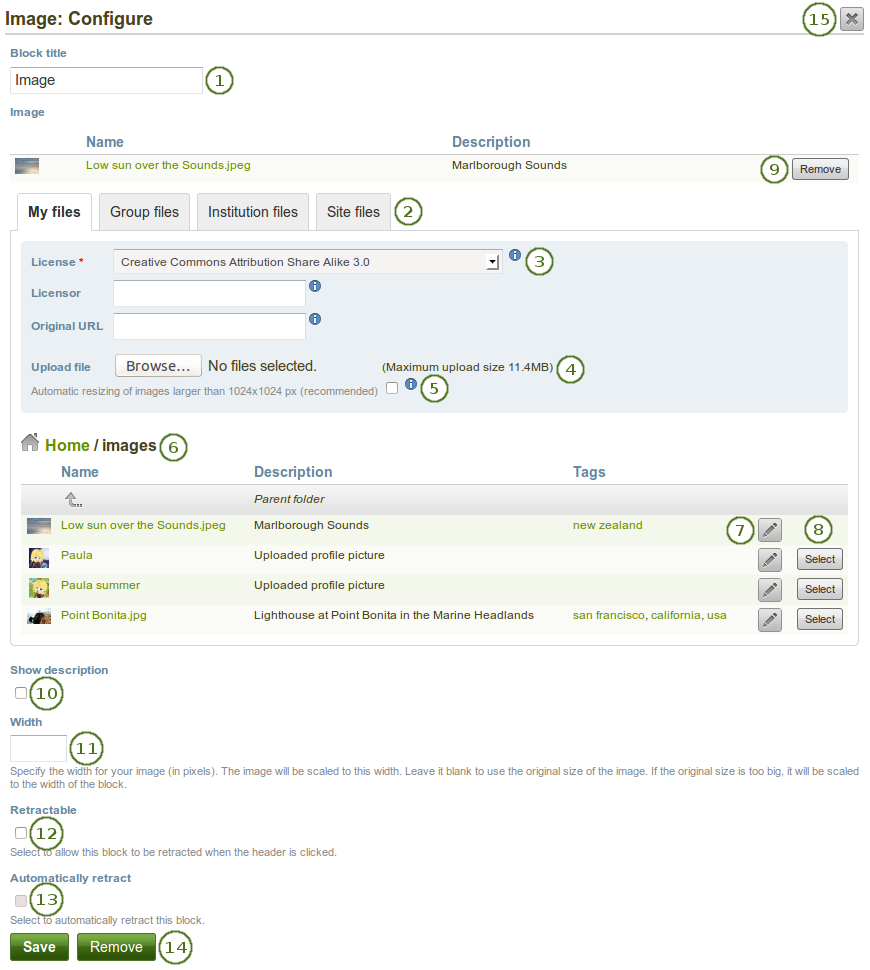
Configure the Image block
Block title: Choose a title for your block.
Files area: Choose from which files area you would like to select an image:
- My files: You see all the folders and files that you have created.
- Group files: You see all the folders and files that you are allowed to publish.
- Institution files: If you are an institution administrator, you will see institution folders and files.
- Site files: If you are a site administrator, you will see all site folders and files. Otherwise, you can only see the ones that are in the folder public in the Site files.
License information: You see these fields if the site administrator turned on license metadata. Additionally, if you are in an institution, your institution administrator may require you to provide a license.
- License: Your default license is displayed. You can set your default license in your account settings. You may choose a different license for each individual artefact.
- Licensor: If you are uploading a file that somebody else created, you can attribute the work to them here and provide their name for example.
- Original URL: If you are uploading somebody else’s file, provide a link to the original Internet address so that others can go there and view the original file.
Upload file: You do not have to go back to your Files area in Content in order to upload a file. You can do so directly from this screen.
If the site administrator turned on the image resizing option, you can decide whether you want to have your images resized if they are larger than the specified dimensions. This option is recommended to save space in your portfolio.
Folder path: The breadcrumbs show in which folder you are currently.
Click the Edit button to change any component of a folder or file, i.e. its name, description and tags. If you have a folder or file included in a page that you submitted for feedback, you will not be able to edit them.
Click the Select button to choose the image file you wish to display in the block.
Warning
When you place group, institution or site files into a page, beware that these files may not be available at some point anymore when the person in charge deletes them.
Click the Remove button if you want to revert your selection.
Show description: Tick this checkbox if you wish to display the description of your photo. It could contain the source of it for example.
Width: Choose the width (in pixels) for your image. If you do not provide a number, the image will be scaled to the width of the block.
Retractable: Tick this checkbox if you want to allow users to reduce the block to its heading on a page. The user can click the Retractable icon
 to just show the heading.
to just show the heading.Automatically retract: Tick this checkbox if you want to show only the block’s heading when a user views the page. The user can click the Retracted icon
 to view the entire block.
to view the entire block.Click the Save button to accept your changes, or click the Cancel button to leave the block’s content as it is. The Remove button is shown only when you place the block into the page for the first time.
You can also click the Close button
 in the top right-hand corner to either remove a newly created block before it is being saved or to cancel any changes and leave the block’s content as it is.
in the top right-hand corner to either remove a newly created block before it is being saved or to cancel any changes and leave the block’s content as it is.
6.1.6. Embedded media¶

Display an embedded video or audio file from your uploaded files. You can display mp3, mp4 and flv files per default.
Note
If you wish to display other file types, the site administrator must allow other media formats. These will not be displayed with the built-in media player but require that you have the correct media player installed to display these videos.
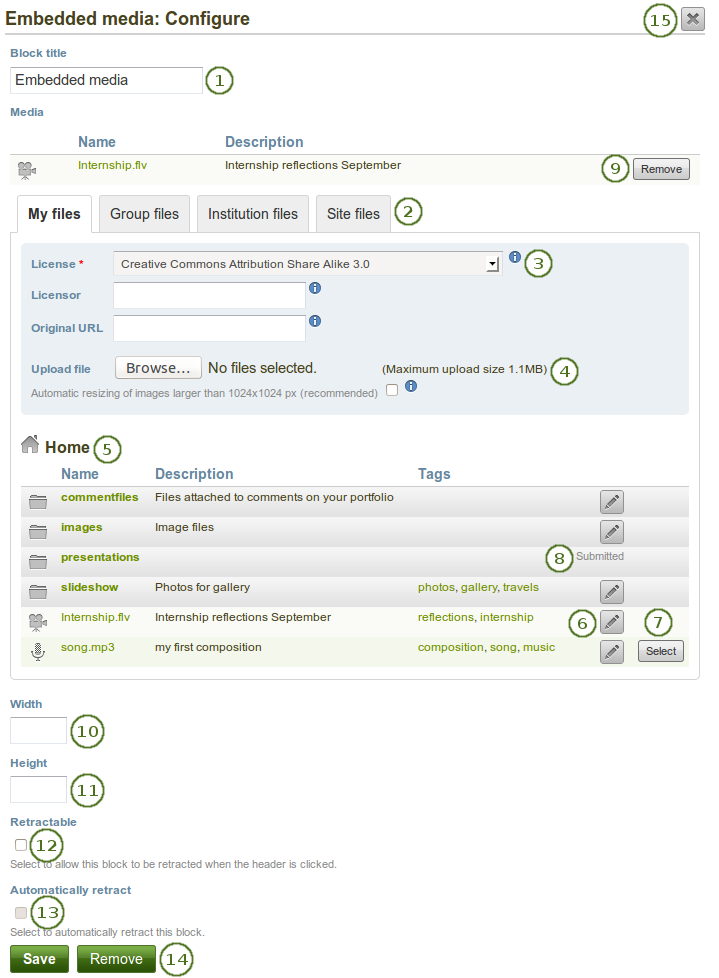
Configure the Embedded media block
Block title: Choose a title for your block.
Files area: Choose from which files area you would like to select a media file:
- My files: You see all the folders and files that you have created.
- Group files: You see all the folders and files that you are allowed to publish.
- Institution files: If you are an institution administrator, you will see institution folders and files.
- Site files: If you are a site administrator, you will see all site folders and files. Otherwise, you can only see the ones that are in the folder public in the Site files.
License information: You see these fields if the site administrator turned on license metadata. Additionally, if you are in an institution, your institution administrator may require you to provide a license.
- License: Your default license is displayed. You can set your default license in your account settings. You may choose a different license for each individual artefact.
- Licensor: If you are uploading a file that somebody else created, you can attribute the work to them here and provide their name for example.
- Original URL: If you are uploading somebody else’s file, provide a link to the original Internet address so that others can go there and view the original file.
Upload file: You do not have to go back to your Files area in Content in order to upload a file. You can do so directly from this screen.
Folder path: The breadcrumbs show in which folder you are currently.
Click the Edit button to change any component of a folder or file, i.e. its name, description and tags. If you have a folder or file included in a page that you submitted for feedback, you will not be able to edit them.
Click the Select button to choose the media file you wish to display in the block.
Warning
When you place group, institution or site files into a page, beware that these files may not be available at some point anymore when the person in charge deletes them.
You can also still select files that have been submitted in another portfolio page.
Click the Remove button if you want to revert your selection.
Width: Choose the width (in pixels) for your video.
Height: Choose the height (in pixels) for your video.
Retractable: Tick this checkbox if you want to allow users to reduce the block to its heading on a page. The user can click the Retractable icon
 to just show the heading.
to just show the heading.Automatically retract: Tick this checkbox if you want to show only the block’s heading when a user views the page. The user can click the Retracted icon
 to view the entire block.
to view the entire block.Click the Save button to accept your changes, or click the Cancel button to leave the block’s content as it is. The Remove button is shown only when you place the block into the page for the first time.
You can also click the Close button
 in the top right-hand corner to either remove a newly created block before it is being saved or to cancel any changes and leave the block’s content as it is.
in the top right-hand corner to either remove a newly created block before it is being saved or to cancel any changes and leave the block’s content as it is.
Note
Only the files that you are allowed to embed are displayed. If you uploaded a mp4 file but it does not show here, you may have to check if it has the correct codec. Only H.264 mp4 files can be embedded.
6.1.7. PDF¶

Embed PDFs into a page.
Note
If your site was upgraded from a previous version of Mahara, your site administrator will need to install the plugin first in the plugin administration.
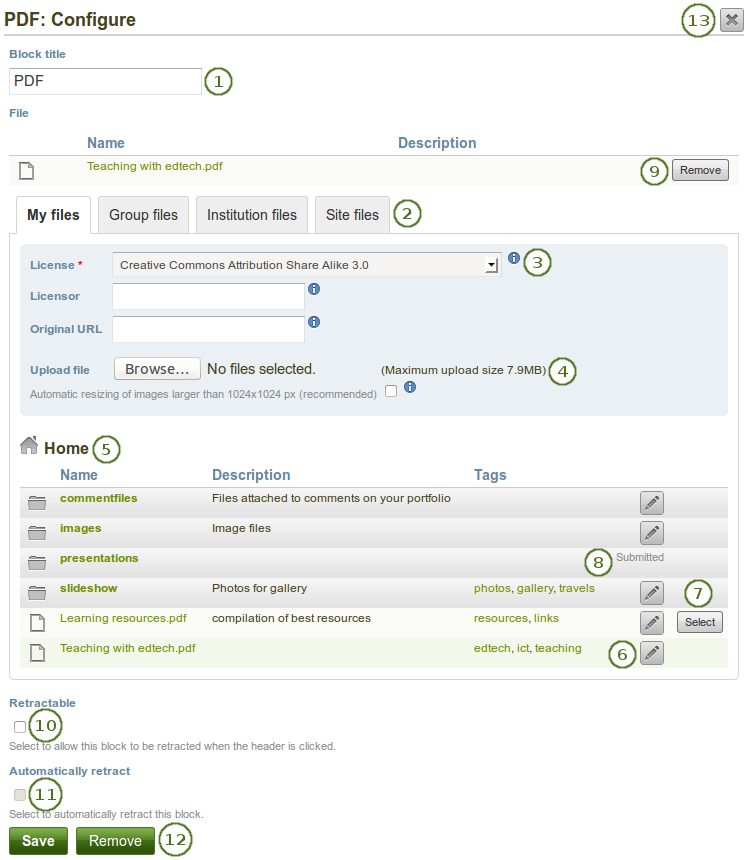
Configure the PDF block
Block title: Choose a title for your PDF block.
Files area: Choose from which files area you would like to select a file:
- My files: You see all the folders and files that you have created.
- Group files: You see all the folders and files that you are allowed to publish.
- Institution files: If you are an institution administrator, you will see institution folders and files.
- Site files: If you are a site administrator, you will see all site folders and files. Otherwise, you can only see the ones that are in the folder public in the Site files.
License information: You see these fields if the site administrator turned on license metadata. Additionally, if you are in an institution, your institution administrator may require you to provide a license.
- License: Your default license is displayed. You can set your default license in your account settings. You may choose a different license for each individual artefact.
- Licensor: If you are uploading a file that somebody else created, you can attribute the work to them here and provide their name for example.
- Original URL: If you are uploading somebody else’s file, provide a link to the original Internet address so that others can go there and view the original file.
Upload file: You do not have to go back to your Files area in Content in order to upload a file. You can do so directly from this screen.
Folder path: The breadcrumbs show in which folder you are currently.
You can still edit any component of the file, i.e. its file name, description and tags by clicking on the Edit button.
Choose the file or files you wish to display by clicking on the Select button.
Warning
When you place group, institution or site files into a page, beware that these files may not be available at some point anymore when the person in charge deletes them.
You can also still select files (within folders) that have been submitted in another portfolio page.
Click the Remove button to not display a specific file in this block anymore.
Retractable: Tick this checkbox if you want to allow users to reduce the block to its heading on a page. The user can click the Retractable icon
 to just show the heading.
to just show the heading.Automatically retract: Tick this checkbox if you want to show only the block’s heading when a user views the page. The user can click the Retracted icon
 to view the entire block.
to view the entire block.Click the Save button to accept your changes, or click the Cancel button to leave the block’s content as it is. The Remove button is shown only when you place the block into the page for the first time.
You can also click the Close button
 in the top right-hand corner to either remove a newly created block before it is being saved or to cancel any changes and leave the block’s content as it is.
in the top right-hand corner to either remove a newly created block before it is being saved or to cancel any changes and leave the block’s content as it is.
Once the PDF is embedded on a page, you can scroll through it and also download it for example. The PDF is displayed in its best possible fit to show one page completely.
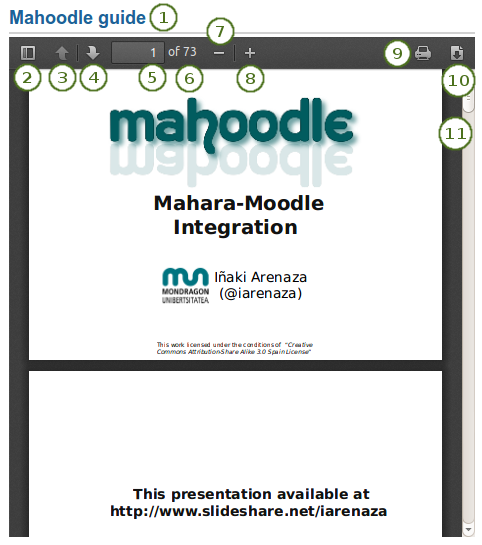
Embedded PDF on a page
- Title of the block.
- Toggle to the sidebar where you can jump from one slide to another either in the thumbnail or document outline view.
- You can move to the previous page.
- You can move to the next page.
- The number of the current page is displayed. You can put a different number in and hit the Enter or Tab key and jump to that directly.
- The total number of pages is shown.
- Decrease the page size by clicking the Minus.
- Increase the page size by clicking the Plus. The block size does not increase.
- Click the Print button
 to print the PDF.
to print the PDF. - Click the Download button
 to download the PDF to your computer.
to download the PDF to your computer. - Use the scrollbar to move through the document.
See also
If you have trouble embedding a PDF file, you might have come across an issue that others have also experienced. The mimetype of the PDF may not be recognized correctly. The correct “mimetype” is “pdf”, but programmes can circumvent using this mimetype for PDFs to ensure that their file is downloaded instead of viewed in the browser for example. There is not an easy fix to this issue, and the discussion of possible solutions has started.
In the meantime, you can delete the incorrect mimetypes from your browser and ensure that only “PDF” is left.

Follow these steps to delete the incorrect mimetypes:
- Close Firefox.
- Locate your profile folder.
- Open the mimeTypes.rdf file in a text editor.
- Search for pdf.
- Leave only the entry that is application/pdf.
- Delete all other PDF references by deleting everything for that entry from
<RDF:Description ...> to </RDF:Description>. - Open Firefox and go to Preferences → Applications.
- Search for pdf. You should now only see one entry that reads “Portable Document Format (PDF)”.